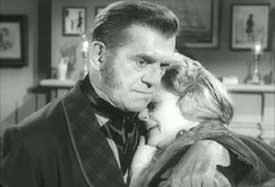 Ten half hour episodes of the intended television series The Veil were filmed in 1958, starring Boris Karloff, who provided an introduction to each episode, & played a different character, either major or minor, in each tale. The series was aborted & never aired, but had been shot on good film stock & properly stored, so exceedingly well preserved. The photography for these is crystal clear, almost cinematic with a crisp noirish beauty. Ten half hour episodes of the intended television series The Veil were filmed in 1958, starring Boris Karloff, who provided an introduction to each episode, & played a different character, either major or minor, in each tale. The series was aborted & never aired, but had been shot on good film stock & properly stored, so exceedingly well preserved. The photography for these is crystal clear, almost cinematic with a crisp noirish beauty.
The DVD revolution has allowed a lot of lost gems of this type to see the light of the home screen. Boris is quite marvelous in his varied performances which lend the series their chief winning attributes. The stories themselves are largely trivial, not the quality of similar television series like Rod Serling's original The Twilight Zone or Boris's well-written Thriller a couple years later. For story value The Veil is a lesser version of One Step Beyond with each supernatural tale alleging to be true.
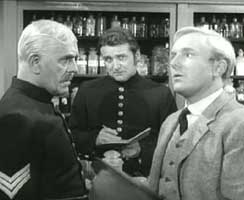 In "Vision of Crime" a man sees his brother murdered, though he's far at sea. Karloff & Patrick McGee play constables. "Girl on the Road" is a version of "The Vanishing Hitchhiker," Boris playing the friend of the haunted man. In "Food on the Table" the ghost of a sea captain's murdered wife angrily tosses food about during her murderer's dinners at the old sailors' hall. Boris is colorful as the killer Captain Elwood. In "Vision of Crime" a man sees his brother murdered, though he's far at sea. Karloff & Patrick McGee play constables. "Girl on the Road" is a version of "The Vanishing Hitchhiker," Boris playing the friend of the haunted man. In "Food on the Table" the ghost of a sea captain's murdered wife angrily tosses food about during her murderer's dinners at the old sailors' hall. Boris is colorful as the killer Captain Elwood.
"The Crystal Ball," set in old Paris, has a jilted lover capable of observing his ex cuckholding her husband, with Boris as the world-wise uncle of heartbroken Edmund. In "The Doctors" Boris is a sweet, elderly physician who in a dream visits the home of a peasant family whose child is in need of medical assistance. He plays an attorney in "Genesis" which has the "lost will" motif with a ghost trying to make things right, Boris in a minor role as a judge.
"Summer Heat" is one of the stronger stories, about a man who witnesses a crime in a Hitchock's Rear Window set-up, but the crime is in the future; Boris is a psychiatrist in this one. "The Return of Madam Vernoy" is a tale of reincarnation. "Destination Nightmare" is a haunted airman story.
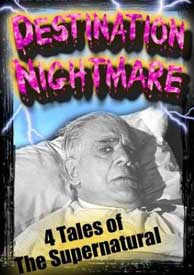 The final episode was apparently purchased already made for a similar series in England. It's a well made mini-film, but lacks even a minor side-character played by Boris. Entitled "Jack the Ripper" it's about a psychic who may know who the Whitechapel ripper is. The final episode was apparently purchased already made for a similar series in England. It's a well made mini-film, but lacks even a minor side-character played by Boris. Entitled "Jack the Ripper" it's about a psychic who may know who the Whitechapel ripper is.
There exists a patched-together anthology film version of four episodes from The Veil, repackaged as Destination Nightmare (1961), & consisting of "The Return of Madam Vernoy," "Destination Nightmare" & "Girl on the Road," but in front of these is an episode lacking in the "complete" set of ten, an eleventh episode that apparently doesn't survive in the original edit as "Whatever Happened to Peggy?" about a teenage girl's horrid encounter with a child ghost.
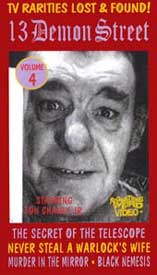 The second disc of The Veil adds two rare episodes of a series produced in Sweden (filmed in English with Swedish subtitles) & never shown in the United States, a similar anthology series, 13 Demon Street, with Lon Chaney Jr. as introductionist.. The second disc of The Veil adds two rare episodes of a series produced in Sweden (filmed in English with Swedish subtitles) & never shown in the United States, a similar anthology series, 13 Demon Street, with Lon Chaney Jr. as introductionist..
There were thirteen episodes,each like miniature Z-horror shlock from the 'fifties, with the same faults & strengths. This is hardly any surprise since the series was created by shlock director Curt Siodmak, who directed most of the episodes himself, & even contributed to the scripting.
Lon is supposed to be the ghost of a criminal whose afterlife punishment is to haunt the address of Number 13 Demon Street until such time as he can learn of a criminal far worse than he had been. What made him so bad we don't find out, but each episode is about a weird crime he hopes the audience will find unequalled in evil.
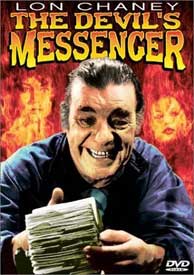 "The Vine of Death" revolves around a 3,000 year old flower bulb planted over the grave of a murder victim. "The Black Hand" is about a hand transplant operation with the donor turning out to be a serial killer, the plot cribbed from The Hands of Orlac. "The Vine of Death" revolves around a 3,000 year old flower bulb planted over the grave of a murder victim. "The Black Hand" is about a hand transplant operation with the donor turning out to be a serial killer, the plot cribbed from The Hands of Orlac.
There also exists an anthology film called The Devil's Messenger (1961) made from reworked & patched together episodes of the series. The frame story is entirely new. Lon is no longer a criminal's ghost, but is now Satan himself, whose female messenger takes "gifts" to individuals among the living who won't be living long.
The television series episodes adapted to this new context tell of a murder victim's vengeful ghost ("The Photograph"); the story of a loony scientist who falls in love with a frozen corpse ("The Girl in the Glacier"); & the tale of a man who dreams of the place where he'll be killed ("Condemned in the Crystal").
The series with Lon as the spirit of crime at 13 Demon Street is also available as a complete set. The rest of the episodes are as follows: "Green are the Leaves" about a haunted portrait in a castle. "The Book of Ghouls" which instructs its reader in a murderous ritual. "Fever" about an artist haunted by an imaginary woman.
"A Gift of Murder" is a voodoo doll story. "The Secret of the Telescope" regards a telescope that reveals its user's death. "Never Steal a Warlock's Wife" is a tale of sorcery, lust, & greed. "Murder in the Mirror" revolves around a crime recorded in a mirror. "Black Nemesis" is about a fraudulent medium.
These are across the board pretty crappy but for fans of shlock horror, 13 Demon Street is like a wonderful sampler of poison chocolates.
copyright © by Paghat the Ratgirl
|
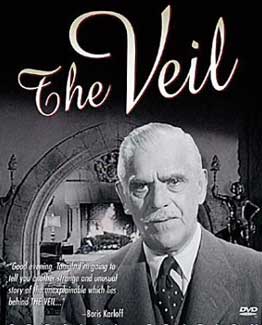

 In "Vision of Crime" a man sees his brother murdered, though he's far at sea. Karloff & Patrick McGee play constables. "Girl on the Road" is a version of "The Vanishing Hitchhiker," Boris playing the friend of the haunted man. In "Food on the Table" the ghost of a sea captain's murdered wife angrily tosses food about during her murderer's dinners at the old sailors' hall. Boris is colorful as the killer Captain Elwood.
In "Vision of Crime" a man sees his brother murdered, though he's far at sea. Karloff & Patrick McGee play constables. "Girl on the Road" is a version of "The Vanishing Hitchhiker," Boris playing the friend of the haunted man. In "Food on the Table" the ghost of a sea captain's murdered wife angrily tosses food about during her murderer's dinners at the old sailors' hall. Boris is colorful as the killer Captain Elwood. The final episode was apparently purchased already made for a similar series in England. It's a well made mini-film, but lacks even a minor side-character played by Boris. Entitled "Jack the Ripper" it's about a psychic who may know who the Whitechapel ripper is.
The final episode was apparently purchased already made for a similar series in England. It's a well made mini-film, but lacks even a minor side-character played by Boris. Entitled "Jack the Ripper" it's about a psychic who may know who the Whitechapel ripper is.
 "The Vine of Death" revolves around a 3,000 year old flower bulb planted over the grave of a murder victim. "The Black Hand" is about a hand transplant operation with the donor turning out to be a serial killer, the plot cribbed from The Hands of Orlac.
"The Vine of Death" revolves around a 3,000 year old flower bulb planted over the grave of a murder victim. "The Black Hand" is about a hand transplant operation with the donor turning out to be a serial killer, the plot cribbed from The Hands of Orlac.